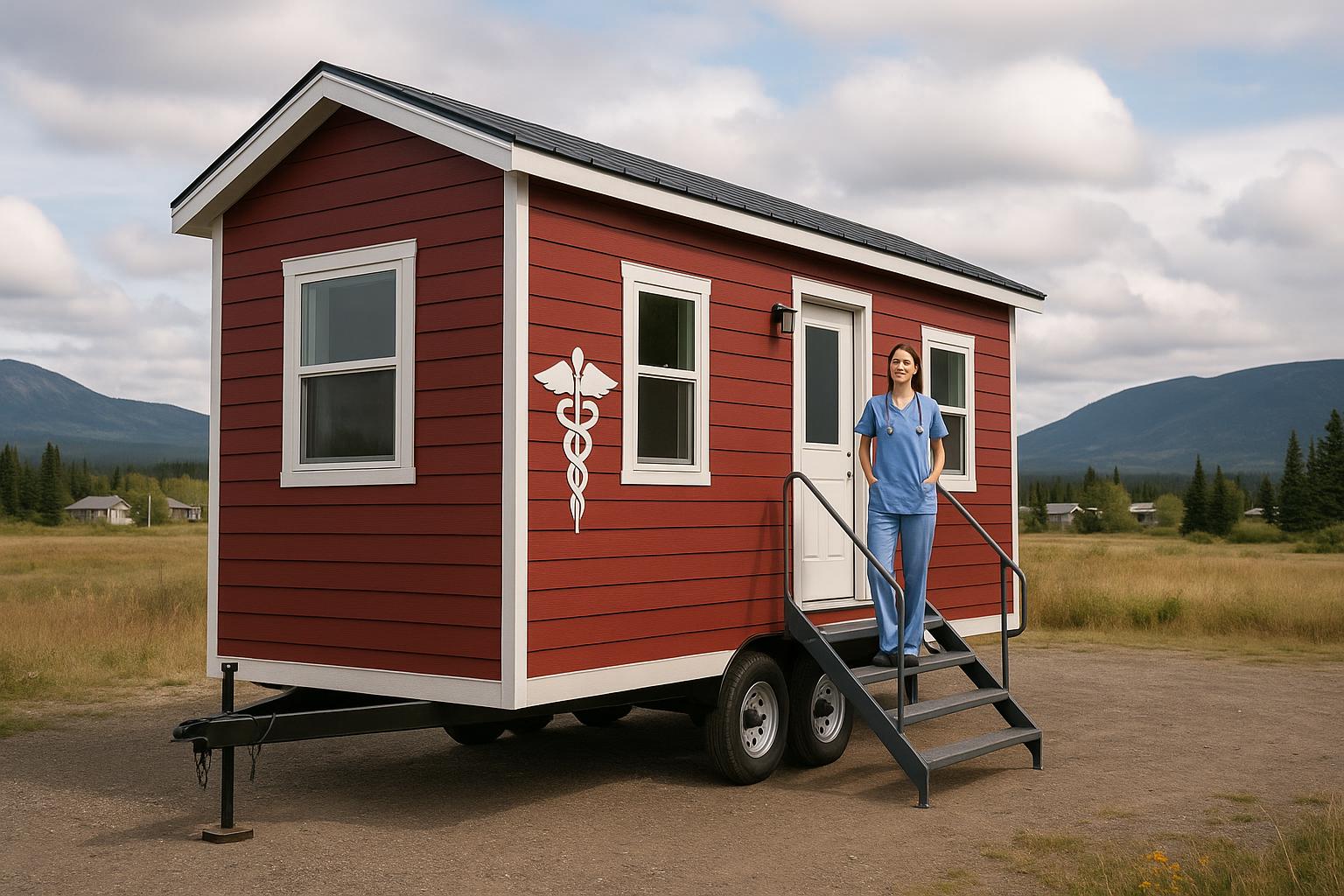
Tiny Home Clinics: Delivering Healthcare Innovation to Remote Communities in Canada
Estimated reading time: 7 minutes
Key Takeaways
- Tiny home clinics bring modern, mobile healthcare services directly to remote communities.
- Cost-effective solutions that reduce travel and logistical challenges.
- They integrate innovative technologies such as telemedicine and digital health records.
- Designed with community needs in mind, they foster local employment and culturally-sensitive care.
Table of Contents
- Introduction: Tiny Home Clinics and the Future of Remote Canadian Healthcare
- Background: Healthcare Challenges Facing Remote Communities in Canada
- What Are Tiny Home Clinics? Defining Tiny Home Clinics
- Mobile Healthcare and Tiny Home Clinics: A Seamless Solution
- Innovations in Healthcare Enabled by Tiny Home Clinics
- Impact on Remote Communities in Canada: Tiny Home Clinics in Action
- Future Prospects and Expansion: Where Canada’s Mobile Healthcare and Tiny Home Clinics Are Headed
- Conclusion: Tiny Home Clinics Powering Healthcare Innovation for Remote Communities
- Call to Action and Additional Resources: Join the Movement for Better Mobile Healthcare in Canada
- Frequently Asked Questions
Introduction: Tiny Home Clinics and the Future of Remote Canadian Healthcare
Tiny home clinics are a groundbreaking medical solution. These are small, often mobile healthcare units created by converting traditional tiny homes into full-scale medical service providers. Rather than being simple shelters, tiny home clinics are equipped with advanced equipment, clean consultation rooms, and modern technology.
Many remote communities in Canada struggle to access regular healthcare. Geographic isolation, extreme weather, and limited infrastructure make even basic medical support a challenge. Thousands of Canadians, particularly in northern regions and Indigenous communities, face hardships like long trips or a lack of medical professionals.
Mobile healthcare has rapidly evolved to meet these needs. By taking medical services directly to patients, wherever they live, tiny home clinics are revolutionizing how Canadians access health services.
Read on to see how tiny home clinics are transforming remote community healthcare in Canada, how they work, their real-world impact, and what the future holds for this innovative solution in mobile healthcare.
https://www.healthcouncilcanada.ca/rural-telemedicine-how-small-town-canadians-are-getting-world-class-healthcare-from-home/
https://pmc.ncbi.nlm.nih.gov/articles/PMC8843960/
https://www.adustart.ca/tiny-home-living-guide
https://www.adustart.ca/portable-homes-mobile-affordable-sustainable
https://www.adustart.ca/indigenous-led-tiny-home-communities
Background: Healthcare Challenges Facing Remote Communities in Canada
Access to Healthcare in Remote Communities
The biggest barrier to healthcare in remote areas across Canada is access. Most northern and rural communities are far from big hospitals, medical specialists, or even basic clinics. Residents often must:
- Travel hundreds of kilometres for appointments, emergency care, or specialist visits.
- Face high travel costs, especially when flights or multi-day accommodations are needed.
- Endure stressful, sometimes risky journeys during poor weather or road closures.
Indigenous and northern populations are significantly affected. Chronic issues include:
- Sparse or non-existent road networks.
- Temporary or seasonal access for many communities.
- Reliance on air or boat transport for critical cases.
Lack of Infrastructure and Medical Professionals
Remote areas usually lack permanent healthcare facilities. Hospitals and clinics, when present, may be outdated or underused due to shortages of:
- Doctors, nurses, paramedics, and specialists.
- Support staff and community health workers.
As a result, primary care and urgent medical needs can be delayed—with serious impacts on health outcomes. For example, some patients in remote Manitoba and the Northwest Territories travel over 500 km for basic visits.
Learn more about these challenges:
https://www.healthcouncilcanada.ca/rural-telemedicine-how-small-town-canadians-are-getting-world-class-healthcare-from-home/
https://pmc.ncbi.nlm.nih.gov/articles/PMC8843960/
https://www.adustart.ca/rural-tiny-home-opportunities
What Are Tiny Home Clinics? Defining Tiny Home Clinics
Tiny home clinics are more than just smaller buildings—they are full-service clinics designed to work wherever people are. Each unit is:
- Purpose-built or expertly retrofitted from popular “tiny home” structures.
- Fitted with medical-grade equipment such as exam tables, diagnostic tools, and digital records systems.
- Equipped with secure patient consultation rooms to ensure privacy.
- Outfitted with proper sanitation stations and waste management systems.
- Ready for digital communication—supporting video calls with specialists and online appointment booking.
Compact Design for Mobile Healthcare Innovation
Despite their small size, these clinics meet strict healthcare standards. Their design includes:
- Efficient floor plans maximizing every square metre.
- Lightweight builds for easy towing or mounting on various transport systems.
- Strong insulation and climate-proof structures for harsh Canadian winters.
- Modular interiors that can be reconfigured for specialty services like dental care, mental health, or eye exams.
Research has shown that even though tiny home clinics are a fraction of the size of traditional facilities, they deliver comprehensive care.
Sources:
https://www.healthcouncilcanada.ca/rural-telemedicine-how-small-town-canadians-are-getting-world-class-healthcare-from-home/
https://www.adustart.ca/tiny-homes-space-cost-sustainability
https://www.adustart.ca/tiny-home-design-canada
Mobile Healthcare and Tiny Home Clinics: A Seamless Solution
The Synergy of Mobile Healthcare and Tiny Home Clinics
Mobile healthcare in Canada now includes telemedicine, traveling nurse teams, and tiny home clinics. This innovative pairing delivers healthcare services directly to people, wherever they live.
- Mobility and Flexibility:
- Rapid deployment to disaster-affected areas such as floods or wildfires.
- Seasonal deployment during tourism peaks or infectious outbreaks.
- Quick setup—most units can be operational within hours.
- Cost-Effectiveness:
- Lower upfront and maintenance costs compared to new hospital builds.
- Ideal for pilot projects and community health startups.
- Adaptability:
- Spaces can be tailored for various specialties like vaccinations, dental care, and chronic disease management.
- Easily reconfigured as community needs evolve.
Supporting research has shown that the tiny home clinic model is favored for its flexibility and cost-effectiveness. Learn more about mobile clinics here:
https://www.healthcouncilcanada.ca/rural-telemedicine-how-small-town-canadians-are-getting-world-class-healthcare-from-home/
https://www.canada.ca/en/economic-development-southern-ontario/news/2021/01/feddev-ontario-supports-next-generation-virtual-healthcare-technology.html
https://www.adustart.ca/portable-homes-mobile-affordable-sustainable
https://www.adustart.ca/mobile-tiny-homes-seasonal-work
Innovations in Healthcare Enabled by Tiny Home Clinics
Healthcare Innovation Delivered in Tiny Spaces
Tiny home clinics are at the forefront of healthcare innovation in Canada’s mobile health sector. Advanced technologies help bridge geographic distances and connect patients with essential care.
- Remote Patient Monitoring:
- “Connected Health Kits” monitor vital signs like blood pressure and glucose levels.
- Data is transmitted in real time to specialists for immediate assessment.
- Telemedicine Integration:
- Encrypted video-links allow city-based doctors to consult with remote patients.
- Store-and-forward systems support off-hour reviews of patient data.
- Digital Health Records and Connectivity:
- Secure cloud-based systems manage scheduling, prescriptions, and follow-up care.
Partnerships among governments, tech startups, and Indigenous organizations are fueling these innovations. Sources include:
https://www.canada.ca/en/economic-development-southern-ontario/news/2021/01/feddev-ontario-supports-next-generation-virtual-healthcare-technology.html
https://www.adustart.ca/tiny-smart-home-canada
https://www.adustart.ca/smart-home-technology-for-adus
Impact on Remote Communities in Canada: Tiny Home Clinics in Action
Transforming Remote Communities Through Tiny Home Clinics
Pilot projects and government-supported studies show that tiny home clinics make a tangible difference. In regions like Northern Ontario and the Northwest Territories, mobile clinics have:
- Reduced patient travel by 30-50%, easing both emergency care and routine specialist visits.
- Enabled better management of chronic illnesses such as diabetes and high blood pressure by bringing care closer to home.
- Improved trust through culturally-sensitive services designed with local and Indigenous leaders.
Additional benefits include improved preventive care, faster deployment during outbreaks, and enhanced health equity.
For further insights, visit:
https://www.healthcouncilcanada.ca/rural-telemedicine-how-small-town-canadians-are-getting-world-class-healthcare-from-home/
https://pmc.ncbi.nlm.nih.gov/articles/PMC8843960/
https://www.adustart.ca/indigenous-led-tiny-home-communities
https://www.adustart.ca/community-led-tiny-home-development
Future Prospects and Expansion: Where Canada’s Mobile Healthcare and Tiny Home Clinics Are Headed
Governments at both federal and provincial levels are closely monitoring the progress of tiny home clinics. Funding and scaling initiatives are particularly focused on:
- First Nations reserves seeking healthcare independence.
- Arctic settlements in Nunavut, Yukon, and the Northwest Territories where remoteness is a challenge.
- Temporary work camps, mining towns, and tourism hotspots that experience rapid population changes.
The Canadian model is exportable due to its community-driven design, cultural appropriateness, and flexible infrastructure.
Funding initiatives are already in place, with federal departments such as FedDev Ontario supporting technology upgrades, staffing, and pilot projects. Learn more:
https://www.canada.ca/en/economic-development-southern-ontario/news/2021/01/feddev-ontario-supports-next-generation-virtual-healthcare-technology.html
https://www.adustart.ca/adu-investment-canada-guide
https://www.adustart.ca/adu-grants-canada-municipal-incentives
Conclusion: Tiny Home Clinics Powering Healthcare Innovation for Remote Communities
Tiny home clinics are transforming Canadian healthcare by addressing long-standing challenges such as distance, limited infrastructure, and a shortage of medical professionals. These innovative clinics offer not only emergency services but also preventive and specialty care directly in remote communities.
As technology advances and community partnerships strengthen, the role of tiny home clinics will continue to grow—paving the way for a more accessible and equitable healthcare system, both in Canada and around the world.
Additional references:
https://www.healthcouncilcanada.ca/rural-telemedicine-how-small-town-canadians-are-getting-world-class-healthcare-from-home/
https://www.canada.ca/en/economic-development-southern-ontario/news/2021/01/feddev-ontario-supports-next-generation-virtual-healthcare-technology.html
https://pmc.ncbi.nlm.nih.gov/articles/PMC8843960/
https://www.adustart.ca/tiny-home-living-guide
https://www.adustart.ca/indigenous-led-tiny-home-communities
Call to Action and Additional Resources: Join the Movement for Better Mobile Healthcare in Canada
Tiny home clinics and mobile healthcare are redefining access to medical services in Canada. If you are a policymaker, healthcare provider, or technology innovator, now is the time to support and expand this model.
- Advocate for increased public funding and clear regulatory frameworks.
- Partner with Indigenous health groups to ensure culturally safe, community-led care.
- Invest in pilot projects, workforce training, and ongoing research.
Further Reading and Resources
- Health Council of Canada: https://www.healthcouncilcanada.ca/rural-telemedicine-how-small-town-canadians-are-getting-world-class-healthcare-from-home/
- FedDev Ontario: https://www.canada.ca/en/economic-development-southern-ontario/news/2021/01/feddev-ontario-supports-next-generation-virtual-healthcare-technology.html
- Canadian Medical Association Journal (PMC): https://pmc.ncbi.nlm.nih.gov/articles/PMC8843960/
- TytoCare: https://www.tytocare.com
- https://www.adustart.ca/tiny-smart-home-canada
- https://www.adustart.ca/mobile-tiny-homes-seasonal-work
- https://www.adustart.ca/community-led-tiny-home-development
Frequently Asked Questions
Q1: What services can tiny home clinics provide?
A1: They offer a range of services including emergency care, telemedicine consultations, preventative screenings, and specialty services tailored to remote community needs.
Q2: How are these clinics adapted for the unique conditions of remote Canada?
A2: These clinics are designed with strong insulation, modular interiors, and digital integration to withstand harsh climates and provide flexible healthcare solutions.
Q3: How can communities support the expansion of tiny home clinics?
A3: Communities can advocate for increased funding, partner with local health organizations, and support training programs to ensure sustainable, community-led healthcare innovation.

Leave a Reply